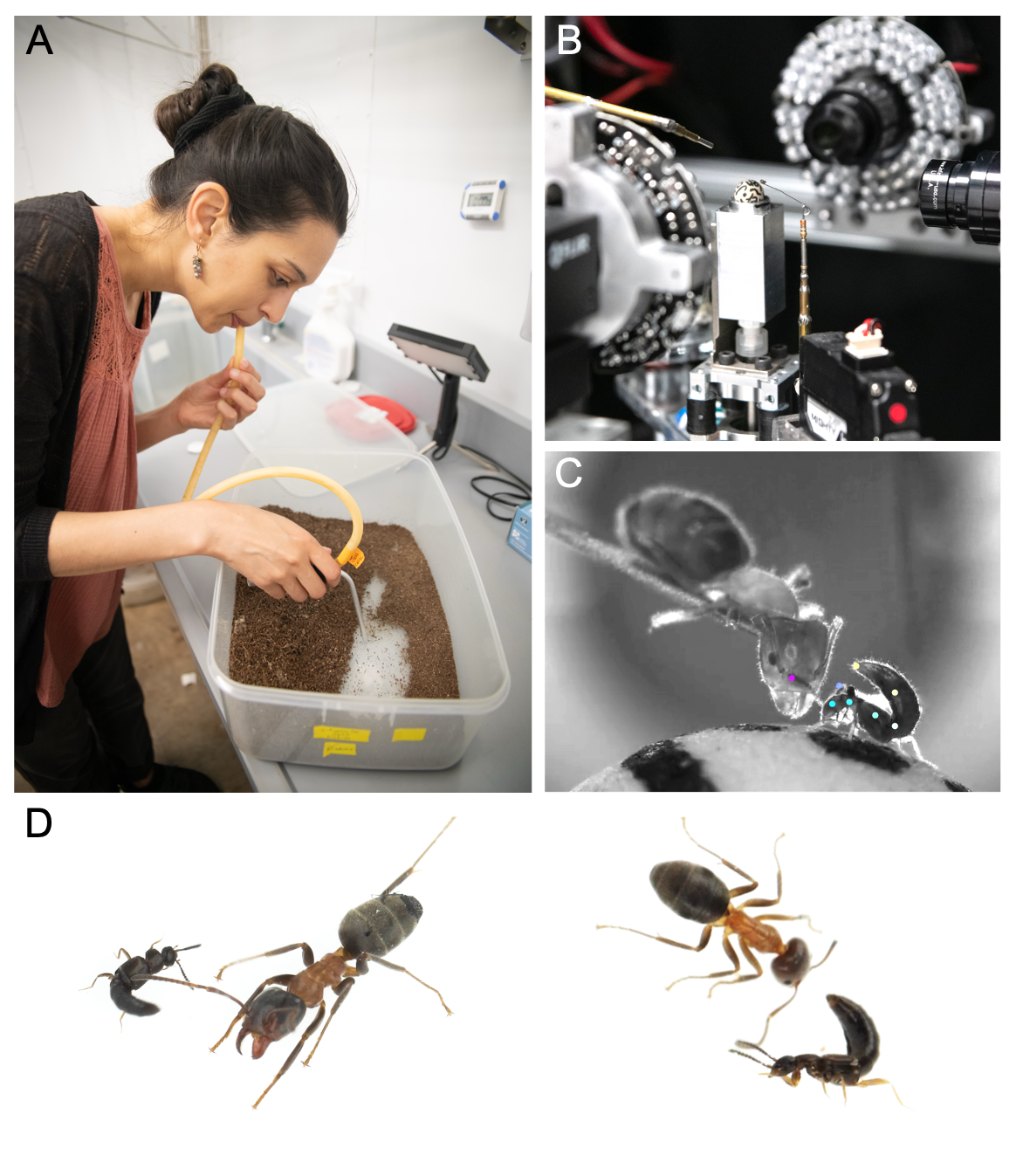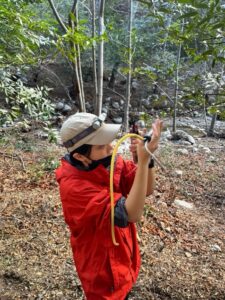Research led by Dr. Jessleen Kanwal reveals how beetles detect and deter danger in ant-dominated ecosystems
By Esther Okamoto

In the densely packed, high-stakes ecosystem of the forest floor, survival often depends on the ability to make fast, accurate decisions. For the tiny rove beetle Dalotia coriaria, navigating this complex terrain means avoiding some of the most formidable predators on Earth—ants. But how does such a small insect outwit these aggressive social predators?
Dr. Jessleen Kanwal, a postdoctoral researcher in Dr. Joe Parker’s lab at Caltech, is uncovering the secret: Dalotia doesn’t just run. It evaluates. It chooses. And when needed, it unleashes a potent chemical counterattack.
Chemical Warfare in Miniature
When threatened, Dalotia engages in a striking defense maneuver: it flexes its abdomen and releases benzoquinones⎯toxic chemical irritants⎯from a specialized gland. This deterrent is powerful enough to send even an aggressive ant scurrying away. But this isn’t a reflexive reaction—Jess’ research shows it’s a highly calibrated decision.
“On my first day in the lab, I was handed a box of dirt and told to look at it under a microscope,” Jess recalls. “What I saw was an entire ecosystem playing out beneath the surface—beetles interacting with ants, predators, and prey. It was immediately clear how dynamic and selective their behaviors are.”
Flex or Flee? Context Is Everything
Jess set out to systematically study how Dalotia decides when and how to deploy its defenses. Using a custom-designed behavioral arena where beetles walked on a floating air-cushioned ball (essentially an insect treadmill), her team simulated close encounters with ants and other species.
They discovered two key behaviors:
- Fleeing: A rapid reorientation and movement away from the approaching ant, even before physical contact—likely triggered by airborne chemical cues.
- Flexing: The dramatic abdominal bend that signals the release of chemical defenses, deployed primarily when contact is made.
Importantly, these behaviors weren’t automatic. Beetles responded differently depending on the identity of the intruder. They flexed strongly in response to predatory ants, showed little to no response to prey like fruit fly larvae, and exhibited moderate flexing during interactions with conspecifics—suggesting the behavior may also play a role in mating or species-specific communication.
The Chemistry of Danger
The key to Dalotia’s threat detection lies in its chemical senses. To test this, Jess and colleagues exposed beetles to glass rods coated with different chemical extracts from ants (Liometopum occidentale). The beetles responded as if a real ant were present—confirming that chemical cues are critical.
Breaking down the extracts further, the team examined responses to specific ant compounds:
- Cuticular Hydrocarbons (CHCs): Waxy compounds on the insect exoskeleton that prevent water loss and mediate species-specific and nestmate recognition
- Sulcatone: An alarm pheromone released by ants
- Iridoids: Trail-marking chemicals
While each class of chemical elicited some degree of response, none alone matched the full flexing behavior seen with the complete ant extract—suggesting Dalotia uses a combinatorial system to evaluate threat.
When Smell Disappears
To dig deeper, the team used CRISPR to create Dalotia mutants lacking the Orco gene, which is essential for olfactory function in insects. These beetles failed to show evasive fleeing behavior in response to distant ants—but surprisingly, they still flexed in close-contact scenarios.
“This tells us that while smell plays a huge role in early detection,” Jess explains, “other sensory systems—like mechanosensation or alternate chemoreceptors—likely compensate when the beetle makes direct contact with another species.”
Why Flex at All? The Cost of Defense
Flexing and releasing chemicals isn’t free. Producing benzoquinones is likely metabolically expensive, and beetles may risk depleting their reserves. Jess suspects that’s why Dalotia exhibits a two-stage response—fleeing first, flexing only when necessary.
Jess and colleagues also found that Dalotia can fine-tune this defensive flexing based on environmental context. For example, when freely moving, the beetles often ignore harmless insects like adult Drosophila flies. But when forced into close, prolonged contact, they deploy their full defensive response. This flexibility suggests that Dalotia weighs the immediacy of the threat before investing in costly chemical defenses, a smart strategy for conserving energy while still staying safe.
Implications Beyond Beetles
The ability to flexibly deploy defenses—and to distinguish between threats and non-threats—is crucial for survival in nature. But in Dalotia, it may also hold clues to how some rove beetles have evolved more elaborate relationships with ants, including species that infiltrate ant colonies by mimicking the chemical profile of their hosts.
“Understanding how beetles like Dalotia detect and respond to ant cues can help us uncover how other species have taken this a step further—not just defending against ants, but fooling them entirely to gain access to food and protection in the ant colony,” says Jess.
A Model for Flexible Behavior
Jess’ work highlights a beautifully tuned defense system—one that’s dynamic, modular, and deeply dependent on environmental cues. In the battle between predator and prey, Dalotia shows that survival isn’t just about strength. Sometimes, it’s about knowing when to flex, when to flee, and—perhaps someday—when to fool.
Acknowledgments: This research was conducted under the supervision of Dr. Joe Parker at Caltech with contributions from Dr. David Miller, Noelle Huget, Mina Yousefelahiyah, Tom Naragon, Jonayet Lavin, Jason Wong, Dr. Will Dickson, Han Kim, and collaborator Dr. Jocelyn Millar (UC Riverside).
Author Bio:
 Esther Okamoto is a PhD student at the California Institute of Technology in Dr. Joseph Parker’s lab, where she studies the evolution of symbiosis and species interactions. Her research focuses on the genomic underpinnings of complex ant societies that host rove beetle myrmecophiles—beetles that integrate into ant colonies and exploit their social systems.
Esther Okamoto is a PhD student at the California Institute of Technology in Dr. Joseph Parker’s lab, where she studies the evolution of symbiosis and species interactions. Her research focuses on the genomic underpinnings of complex ant societies that host rove beetle myrmecophiles—beetles that integrate into ant colonies and exploit their social systems.

